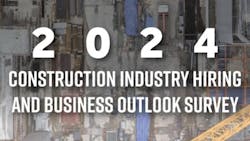Water and sewer construction nosed out highways and bridges as the most positive sector for project demand in 2024, according to a survey of contractors conducted by the Associated General Contractors of America and Sage. The research report identified 14 of 17 categories of construction where more respondents expected an increase in dollar value of projects than expected a decrease.
Construction sectors growing in 2024
- Water and sewer recorded a net of 32%,
- Transportation (transit, airport, rail): 30%
- Bridge/highway: 30%
- Federal, such as VA and GSA: 29%
- Power: 25%
Construction sectors declining in 2024
- Private office recorded a net of -24%,
- Retail: -15%
- Lodging: -3%
Read also: 2024 Prices Remain a Concern for Fleets
“2024 offers a mixed bag for construction contractors: on one hand, demand for many types of projects should continue to expand and firms will continue to invest in the tools they need to be more efficient,” said Stephen E. Sandherr, CEO, in a statement. “Meanwhile, they face significant challenges when it comes to finding workers, coping with rising costs, and weathering the impacts of higher interest rates.”
The net reading for federal projects is 29%. The highest expectation among predominantly private-sector categories is for power projects, with a net reading of 25%. Close behind are the readings for hospital construction, with a net of 23%; and non-hospital healthcare facilities, such as clinics and medical labs, with a net of 22%.
The largest increase in optimism from the previous survey is for data center construction, with a net positive reading of 20%, up from 12% a year ago. Contractors are optimistic, as well, about the education sector. The net reading is 18% for K-12 schools and 15% for higher education construction. The net reading for both public buildings and manufacturing construction is 15%. The net is 10% for warehouses.
“On balance, contractors remain upbeat about the available dollar value of projects to bid on in 2024,” said Ken Simonson, chief economist, in a statement. But the optimism regarding opportunities for most project types is less widespread than it was a year ago.”
Simonson noted that more than two-thirds (69%) of the respondents expect to add to their headcount, compared to only 10% who expect a decrease. Although just under half (47%) of firms expect to increase their headcount by 10% or less, nearly one-quarter anticipate larger increases. Yet 77% of respondents report that they are having a hard time filling some or all salaried or hourly craft positions. The majority (55%) expects that hiring will continue to be hard (35%) or will become harder (20%).
Most firms took steps in 2023 to attract and retain workers. Sixty-three percent increased base pay rates more than in 2022. Additionally, 25% of firms provided incentives or bonuses, and 24% of the firms increased their portion of benefit contributions and/or improved employee benefits.
As in the past two surveys, nearly two-thirds of respondents say projects have been postponed or canceled. Almost equal percentages of firms report projects were postponed or canceled in 2023 and not rescheduled (36% of respondents) as report projects were postponed but rescheduled (37%). Ten percent have already experienced postponement or cancellation of a project that had been scheduled for the first half of 2024.
Only 23% of respondents say they have not had any significant supply-chain problems. Sixty-four percent noted that rising interest rates or financing costs are one of their biggest concerns for 2024, 63% listed insufficient supply of workers or subcontractors, and 62% are worried about the likelihood of an economic slowdown/recession. In addition, 58% listed rising direct labor costs (pay, benefits, employer taxes), while 56% pick worker quality and 54% list materials costs as major concerns for the year.
Officials with Sage noted that construction firms have been seeking ways of adapting to the shortage of skilled workers and improving jobsite safety and productivity. Nearly 40% of firms say they will either increase their investment in drones (26%) or make an initial investment (14%). Thirty percent of firms will make an initial investment in artificial intelligence (19%) or increase their investment (11%). And almost 30% plan to make more use of offsite production (21%) or start to (9%).
“Technology has played an instrumental role in helping construction firms build more efficiently while navigating current challenges,” said Dustin Stephens, VP of construction and real estate for Sage, in a statement. “In this era of digital transformation, technology serves as a cornerstone for sustained growth and success.”
Stephens added that nearly all firms plan to increase or keep level their investment in software. The most likely candidates for increased software spending are accounting software and project management software: for each type, 38% of respondents expect to increase their investment. Close behind is document management software, cited by 36% of firms. Thirty-one percent plan to increase spending on estimating software.
About the Author
Rod Sutton
Sutton served as the editorial lead of Construction Equipment from 2001 through 2025.
